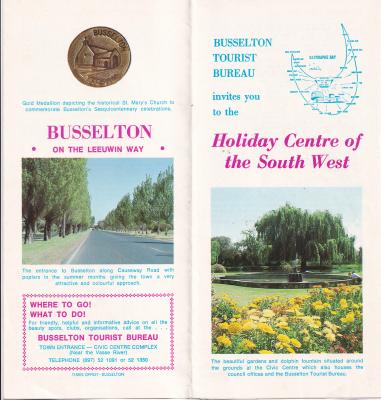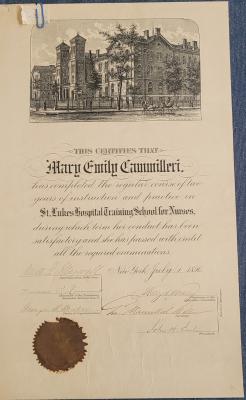Monarch Solo Button Accordion
1890The Monarch Solo diatonic button accordion (or Melodeon) has a wooden frame, which would be held by the player, connected by 15 fold black fabric bellows with metallic corner protectors. All corners of the wooden frame are also covered with rounded metal protectors.
On the treble / melody side key board there are 2 rows of buttons with the outer row having 11 buttons and the inner row 10 buttons and there are 2 rows of 6 buttons on the base end. The melody end of the accordion has a thin silver coloured metallic (possibly tin) protective plating over the keyboard and frame end. The tin plating over the end of the accordion frame has been cut with decorative patterns and covers a flyscreen netting which allows the movement of air. The flat base end is made of wood with 2 sets of holes in a circular pattern that covers a flyscreen netting , once again to allow air movement. The woodwork on the frame has been carved with decorative patterning that follows the straight edges. The melody frame end of the accordion can be opened for cleaning and is held closed by 2 brass hooks and the accordion bellows are held in their closed position by a leather strap. Another leather strap is provided to support the instrument for the player.
Austrian inventor, Cyril Demian, patented the first diatonic button accordion in 1829 which was the same year Charles Wheatstone made the first concertina. The name 'Accordion' is thought to originate from the German word for chord “Akkord”. The button accordion was first mass-produced in Europe in 1835 and whilst not cheap it was the first mass-produced instrument that could be easily carried by people as they travelled. At first, the button accordion was too expensive to be popular with the lower and middle classes but this changed as it became cheaper in the 1860s. Surviving early instruments show that they only played chords, were played left-handed, had only 5 buttons (10 chords) indicating were mostly used for accompaniment.
Details
Details
Engraved into the treble side frame
Monarch Solo
On a plate on the side
A&D
A button accordion is a type of accordion which has buttons rather than a piano style keyboard and are particularly common in European countries and countries where European people settled.
A Melodeon or diatonic button accordion is a member of the reed free aerophone family of instruments. The melody (treble) side keyboard has one or more rows of buttons, with each row producing the notes of a single diatonic scale. Pushing or pulling the bellows slower or faster makes the sound softer or louder, respectively. The accordion has free reeds on both the treble and bass sides. The press of a button opens a valve to allow air to pass through the reeds to make a sound when the bellows are pumped in or out. In the diatonic button accordion, reeds are fixed in pairs so that one note sounds when air moves in, and a different one when air moves out. The button accordion has melodic (treble) notes on one side of the bellows (usually the right side), and bass accompaniment notes on the other side (generally the left).
This accordion was made in 1890 and belonged to Phil Overton's father. It was donated by Frank Johnson who's family were group settlers at Ambergate
More items like this
Other items from Busselton Historical Society
- Concertina
- Hohner Double Ray Delux Button Accordion
- Zither
- Violin
- "Stainer" Violin
- Postcard - Railway Station, Busselton
- Autoharp / Chorded Zither
- Busselton Brass Band - Bass Drum
- Western Australia Duty & Tax Stamps Collection
- Tourism Brochures - Busselton
- Souvenir Ribbon - Busselton Bypass 2000
- Certificates - Mary Cammilleri Wood
Scan this QR code to open this page on your phone ->






